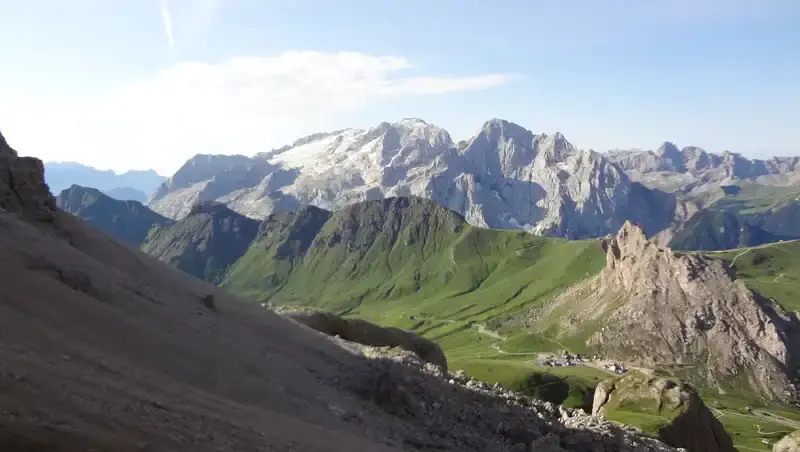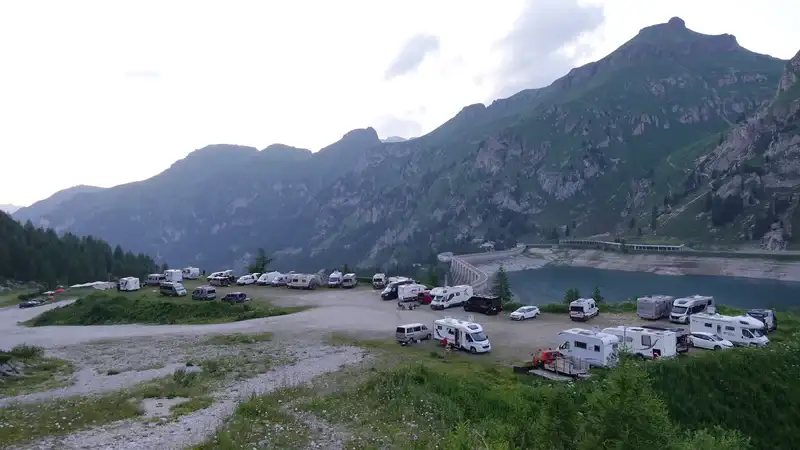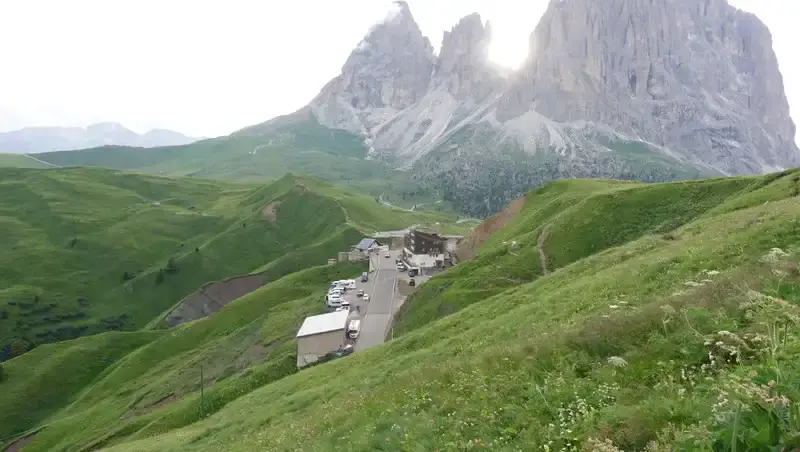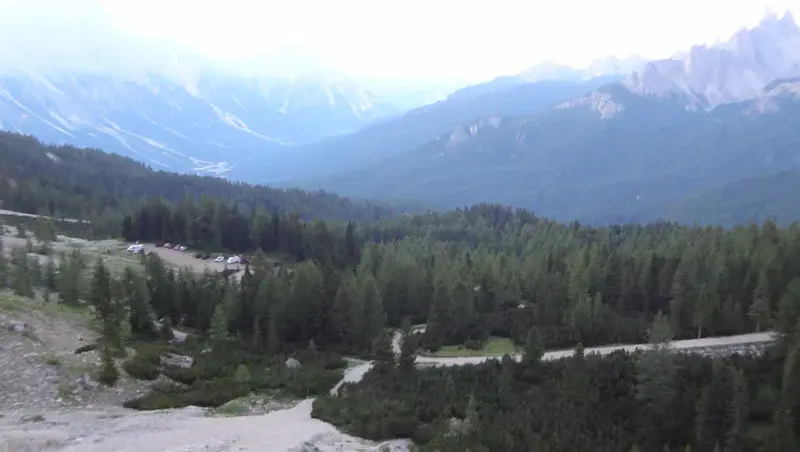There is a lot of discussions in various online groups and forums about sleeping on high passes in the Dolomites, and this frequently includes misinformation detached from reality. Here you can read about real life practices and official regulations.

Recently, when I gave a reply to somebody’s question on a FB group, I got a comment by an angry person who wrote: “Wild camping is illegal and the government has a very strict view on this. Telling that camping on passes is tolerated is a misinformation…”
Of course, nobody was talking about camping, the person was simply collecting “likes”. You have probably seen them in many of such groups. They sit there in multiple group policing and commenting; I noticed that the person had “raising contributor” title attached to his name.
In fact, I am pretty sure that nobody really camps at high passes. But you will read more about this below, it depends on how you define camping, or more importantly how this is defined by the Italian regulations.
Note that about issues of camping I have yet another detailed article here in the site.
Real life situations
When you are on any of high passes in the Dolomites, you will see two different populations.
During the day, these places are full of people from the surrounding valleys, locals or tourists, that get to such high ground by car and then do hiking tours around. In the afternoon they go back.
Then, they are replaced by others who come with cars, vans, and motorhomes in search for a parking place to spend the night. Next morning, this population moves elsewhere, and then next late afternoon they may return to the same place, or look for another pass or parking to spend the night.
I have seen this many times, and I can say that literally hundreds of people sleep every night at high passes and road parking places in general.
You see the picture below, I took it on Fedaia pass. As you realize, there are tens of motorhomes and cars there.

Note, this is not an official camp spot. This is just a parking on the Marmolada side of the like. To get there, you have to drive over the dam that is visible in the photo.
There is yet another on the opposite side, close to the road when you drive in the right direction in the picture.
Have a look also at the photo below, I took it as I was getting back from my long round tour that included ferrata Possneker. So this is Passo Sella where I slept in the car.
There is not much space there, but at least 20 vehicles were there that night in the area around the hotel on the highest point of the pass. Of course, people where sleeping there, me included.

But it is not only about high passes, people sleep in vehicles everywhere. Below you can see my photo of the parking at Angelo Dibona hut. I slept there in the car before climbing Tofana di Rozes. This is early morning and you can see the cars and vans where people were sleeping.

You will see the same on huge parking area below Passo Tre Croci on the Cortina side, close to the lift station.
The same is at Pie Tofana parking close to the lift station Col Drusciè. This was my start point where I slept in the car before my tour to Tofana di Dentro.
What the law says, can you sleep on road parking in the Dolomites?
Now, let’s see if this is legal or not. There are several articles in the Codice della Strada (Italian Highway Code), enacted under Legislative Decree No. 285 of April 30, 1992, and its subsequent amendments, that are of interest for this topic.
In particular, they include Article 185 and Article 158.
The Codice della Strada does regulate vehicle use on roads, including parking and stopping, and Article 185 actually deals with “Rest and refreshment areas along motorways,” which may not be directly relevant to space occupation in the Dolomites.
For example, the rules for the Parco Naturale delle Dolomiti d’Ampezzo explicitly state: “Camping either in tents or campers is not allowed” within the park, though parking in designated areas is permitted.
This suggests that stopping with a vehicle (like a camper van) to sleep inside it might be okay in some spots, as long as you’re not setting up external structures.
In many Italian park regulations, camping implies setting up temporary shelters or equipment (tents, tables, chairs) beyond the vehicle’s footprint.
Sleeping inside a camper van, where everything stays contained within the vehicle, is often treated as parking rather than camping, provided you are in a legal parking area and not a no-stopping zone.
However, popping out a table and chairs extends your occupation beyond the vehicle’s space, which could easily be interpreted as camping, especially in a protected area like the Dolomites, where enforcement can be strict to preserve the landscape.
To confirm this, I checked regional sources. The Dolomites’ tourism boards and park websites (like dolomitiparco.com) emphasize that wild camping is banned, but they don’t really explicitly forbid sleeping in a vehicle in permitted parking zones.
Local bylaws in municipalities like Cortina d’Ampezzo might further refine this: they can prohibit certain activities on public roads or lands under their jurisdiction (per Article 185) of the Codice della Strada, which allows municipalities to regulate highways.
Anecdotally, travelers on forums report sleeping in camper vans in Dolomites parking areas without issue, as long as they don’t set up external gear.
So, no single Article 185 in the national traffic code says “don’t occupy more space than the vehicle itself,” but the principle emerges from a mix of the Codice della Strada’s parking rules and Dolomites-specific park regulations.
You can likely stop and sleep in your vehicle in a designated parking spot, but putting out a table and chairs crosses into camping territory, which is forbidden outside official campsites.
In fact, this was told to me by an Italian on Passo Valparola, and I did not really believe him completely. But from all I read and see in real life, it seems this is so.
If you go back to the Fedaia pass photo above, you will notice that some people were using chairs and tables outside. It was not surprising, the weather was perfect and the photo was taken during a very pleasant dusk hour.
My guess is they were not aware of the issues discussed here in the text. But it may also be that they did not expect any control, the parking is quite away from the main road which is on the other side of the lake.
In any case, to be certain, always check the local rules of the specific Dolomites area you are visiting. Regulations can also vary slightly between Trentino, Alto Adige, and Veneto. These three provinces cover the Dolomites area.
Where you cannot stop and stay the night
The Article 158 lists the places where stopping is prohibited.
Vehicles are not allowed to stop, either temporarily or for extended periods (e.g., overnight stays in a camper) at the following places:
- On pedestrian crossings or within 5 meters of them to ensure pedestrian safety.
- On road junctions or within 5 meters of them to avoid obstructing traffic.
- On curves or near the crest of a hill where visibility is limited, as it poses a risk to other drivers.
- In tunnels, underpasses, or bridges unless specifically designated parking areas exist, due to safety and ventilation concerns.
- On tram or railroad tracks.
- In areas marked with a stop or yield sign to maintain clear sightlines.
- On road shoulders or emergency lanes (unless authorized), except in cases of breakdown or emergency, and even then, warning signs must be used.
- In front of entrances or exits (private or public).
- In areas reserved for public transport or disabled parking.
- Where stopping would obstruct traffic or create danger, determined by local conditions.
- In no-stopping zones (marked by signs).
As you see, there is nothing really special here, these are typical rules that apply everywhere.
Relevance to the Dolomites
In the context of the Dolomites, Article 158 complements Article 185 (which allows overnight stays in campers under specific conditions).
The prohibitions in Article 158 mean you cannot stop your camper in any of the above-listed locations, even if you intend to sleep inside it.
Source and verification
The content of Article 158 is derived from the official Codice della Strada (Legislative Decree No. 285/1992), available through Italian government legal databases like the Gazzetta Ufficiale or the Ministry of Infrastructure and Transport website.
Since the law is subject to amendments, the exact text might include minor updates, but the core prohibitions listed above are standard as of March 17, 2025.
If you need the precise, current legal text (e.g., for a specific clause or amendment), I recommend consulting an official Italian legal resource or a local authority in the Dolomites.
Any recent updates?
I have searched recent web sources and posts for updates on parking and sleeping regulations in the Dolomites. As of now, there don’t appear to be significant legislative changes to the Codice della Strada (Italian Highway Code) or Dolomites-specific park rules since early 2025.
However, here are some observations. There are posts on travel forums (e.g., camper groups) that continue to debate enforcement levels.
Some users report possibilities for stricter patrols in popular areas like Passo Sella and Passo Fedaia during peak seasons (summer 2025 preparations are being discussed), with fines issued for external setups (e.g., tables or awnings).
There is chatter about municipalities like Cortina d’Ampezzo considering tighter parking restrictions near lift stations (e.g., Pie Tofana) due to overcrowding complaints in 2024. But I was there in high season the same year, and it was not overcrowded at all, so I am really confused.
No formal changes are confirmed as of March 27, 2025, but it’s worth monitoring local tourism boards or park websites (like dolomiti.org) for updates if you are planning a trip.
Environmental groups have been vocal about protecting the Dolomites, advocating for broader bans (including tighter rules on overnight vehicle stays). While no new laws have passed, this could signal future regulatory shifts, something to keep an eye on.
In general, the situation remains fluid, especially with tourism pressures. But if I hear anything, this text will be updated, so stay tuned and bookmark this post.
Final thoughts
I wish to stress that everything presented here is based i) on information available online on various official sites, and ii) on my own first-hand experience. However, whatever you do in the Dolomites is up to you and your own responsibility.
My advise would be that you try to remember the mentioned legislative decree. If you are ever visited by police on a pass or parking, you may mention it and impress the police. But, I would point out that I have never seen police inspecting and controlling people at such places, just to know.
Bear in mind also that there are at least 35 official campsites in the Dolomites, so to play safe you can make reservations there. With an app you can have them all at hand and with all necessary details.
Thank you for reading. For more texts of this type please check under the category FAQs.
Let me know if you have questions or comments, there is a comment box below. Subscribe to my weakly newsletter and stay informed, the subscription form is given below.
Leave a Reply